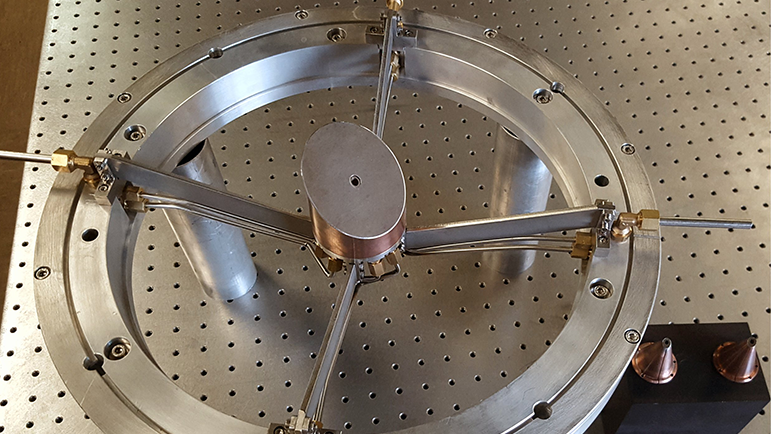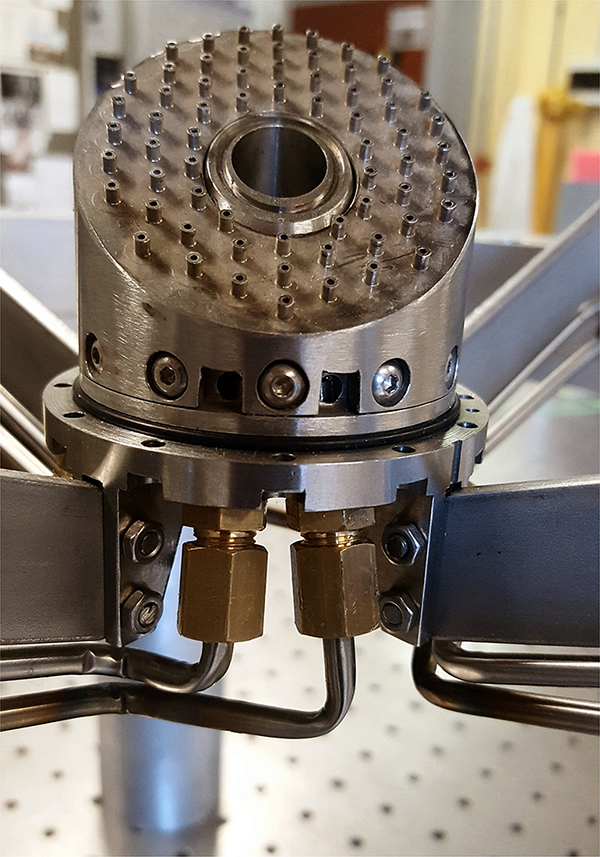Legend has it that Archimedes used a giant mirror to set fire to the Roman ships that attacked Syracuse in 212 BC. No one knows if this is true, but there is some truth to the story: after all, concentrating the sun's rays on a piece of wood can make it burn. A solar telescope is basically a mirror that reflects the sun's rays onto a single focal point, so why does the system not overheat? The answer lies in these two words: heat rejecter.
 Heat rejecter prototype for the GREGOR telescope (plus spider ring). The mirror in the EST unit will be 200 mm in diameter and inclined by 45 degrees. It will be placed at the position of the primary mirror focal plane. The GREGOR prototype was realised in collaboartion between UToV and SRS Engineering. Pictures in this article are courtesy of Francesco Berrilli.
Heat rejecter prototype for the GREGOR telescope (plus spider ring). The mirror in the EST unit will be 200 mm in diameter and inclined by 45 degrees. It will be placed at the position of the primary mirror focal plane. The GREGOR prototype was realised in collaboartion between UToV and SRS Engineering. Pictures in this article are courtesy of Francesco Berrilli.
Self-explanatory in its name, a heat rejecter is a seemingly simple device: a 200-millimetre diameter, 45-degree inclined mirror located at the primary focus of the telescope. A central hole allows light corresponding to the desired field of view to pass into the optical path, while the rest is reflected by the mirror, thus eliminating excess energy. This prevents the structure of the telescope and the air that surrounds it from overheating, which in turns prevent turbulence from happening (this kind of turbulence is called internal seeing, and make images to appear blurred and flickering).
While the mirror will remove most of the unwanted heat (it will have a special coating with a 99% reflectivity), it is not enough. That’s why it will have a dedicated cooling system.
“Immediately behind the mirror surface there will be dozens of high-pressure liquid jets at a temperature lower than the environment —but not too cool, to prevent the formation of dew”, explains Francesco Berrilli, from the University of Rome Tor Vergata (Italy).
This technology is called Multiple Jet Impingement, and it's similar to the one used in the cooling systems adopted in nuclear fusion reactor divertors.
A technology akin to that of a nuclear facility
"The problem with solar telescopes is not the amount of energy per second they receive —which is about 13kW, similar to what thirteen domestic irons would produce. The real problem is the density of that energy, the fact that it is concentrated in a very small area at the prime focus," says Berrilli.
The use of nuclear technologies makes a lot of sense, as the energy concentrated on the focal plane can reach 5 million watts per square metre, a density similar to that of the core of a nuclear reactor.
In fact, the heat density at the focal point is so high, that in case of impingement failure the heat rejecter's mirror would probably melt within a few minutes, and the liquid in the cooling system would reach boiling temperature even earlier.

To avoid this, the heat rejecter has safety systems which, in the event of an abnormal temperature rise, would send an alarm to the main control system of the telescope (which, in turn, would place a shutter over the primary mirror to block the light).
A redundant system
Impingement is not the only cooling technology used in the heat rejecter: there is also air suction. "When an optical surface is heated a few degrees above the ambient temperature, heat plumes start to emerge from it. The air suction system is actually an airflow that will cut the plumes if they occur", says Berrilli.
Having two cooling systems will completely ensure the effectiveness of the heat rejecter: "We believe that the mirror and the first cooling system alone (which reduces the temperature difference between the mirror surface and the environment) will be sufficient to eliminate internal seeing, but by adding this air knife to cut the thermal plumes we hope that convection will be completely eliminated from the interior of the telescope," concludes Berrilli.
For more information:
- Berrilli, F., Egidi, A., Del Moro, D., Manni, F., Cocciolo, M., Scotto, A., Volkmer, R., Bettonvil, F. C. M., Collados M., Cavaller Márquez, L., Sánchez Capuchino, J., The heat stop for the 4-m European Solar Telescope, in Ground-based and Airborne Telescopes III, edited by Stepp et al., Proceedings of the SPIE, Volume 7733, article id. 77332Z, 2010
- Berrilli F., Giovannelli L., Manni F., Del Moro D., Calchetti D., Viavattene G., Laboratory tests of the GREGOR Jet Impingement Heat Rejecter prototype. To be presented at SPIE Astronomical Telescopes + Instrumentation Digital Forum Meeting 13—18 December 2020.
